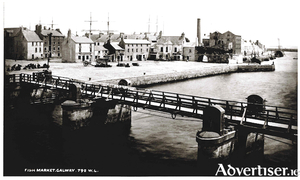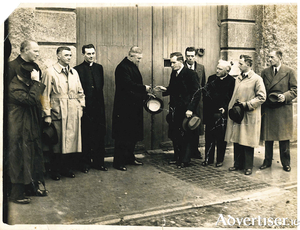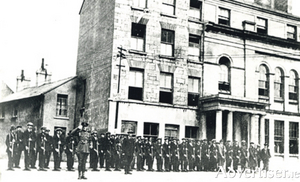Search Results for 'Eamonn Corbett'
5 results found.
Wolfe Tone Bridge

Wolfe Tone Bridge was the third bridge to be built over the river. The West Bridge (now known as O’Brien’s Bridge) was the first and dates from medieval times. The Salmon Weir Bridge dates from 1820, and the Wolfe Tone Bridge was built in the mid-19th century.
The handing over of Galway Gaol

Galway City and County gaols were built at the beginning of the 19th century on a large site which took up most of Nuns Island. Construction was conditional on a right of way, the road all around the walls, also being built. James Hardiman, the historian, described it as follows: “The Prison …. Is built in the form of a crescent …. The interior of which is divided into eight wards ….. separated by walls which form so many radii of a circle, and, terminating in the rear of the governor’s house, bringing the whole range within many of his windows, by which means he can, at a single glance, survey the entire.”
‘Laughter and fun never deserted them’.
Early on Easter Monday morning, April 24 1916, the Galway Volunteers sprang into action. It was a chaotic beginning to the rebellion which hoped to see a nation-wide rising of fully armed and committed men and women seizing control of the country. We know, however, the capture of the ship Aud, with its weapons, explosives and ammunition, off the Kerry coast on Good Friday, prompted the Dublin leadership to cancel the Rising. The order was ignored by Padraic Pearse and others, who had the benefit of arms imported into Howth two years previously. They took over key positions throughout Dublin city, which they held for six days.
‘Laughter and fun never deserted them’.
Early on Easter Monday morning, April 24 1916, the Galway Volunteers sprang into action. It was a chaotic beginning to the rebellion which hoped to see a nation-wide rising of fully armed and committed men and women seizing control of the country. We know, however, the capture of the ship Aud, with its weapons, explosives and ammunition, off the Kerry coast on Good Friday, prompted the Dublin leadership to cancel the Rising. The order was ignored by Padraic Pearse and others, who had the benefit of arms imported into Howth two years previously. They took over key positions throughout Dublin city, which they held for six days.
St Patrick’s Day parade in Galway, 1916

This parade started from the Square in the following order: Eyre Square North – Industrial School Band; Galway Urban District Council; Galway Board of Guardians; Students of UCG; AOH. Eyre Square East – The Monastery School Fife and Drum Band; UIL; Town Tenant’s League; Galway Woollen Manufacturing Co; and the Irish National Foresters.

